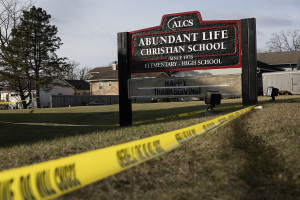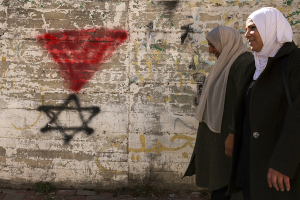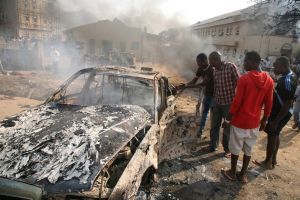Denominational Church Planting Leaders Challenged to Relevancy, Fruitfulness
NASHVILLE, Tenn. – Church planting leaders from more than 30 denominations and organizations gathered Aug. 16-17 at LifeWay Christian Resources to engage in a church planting conversation and to share insights during the Church Planting Leadership Fellowship (CPLF).
"Urban church planting" and "raising up non-clergy church planters" were the specific topics of the peer-learning event organized by Ed Stetzer, director of LifeWay Research.
"I'm delighted to bring this kind of group together to talk about multiplying churches," Stetzer said. Denominational variances aside, Stetzer said, "it is bad stewardship and irresponsible missiology" for church planters not to find ways to learn from each other, which is the purpose of the CPLF. "So, when the Mission America Coalition asked me to convene a group, I was glad to create a learning community.
"The bottom line is, it is a bad idea theologically, with bad results historically, for us to partner and jointly plant churches," he added. "I don't think that Presbyterians and Baptists should plant churches together – that only works until the first baptism, and then you can't decide if you need a cup or a tub. But we can learn together."
The CPLF is made up of evangelical leaders from different denominational agencies and organizations that plant multiple churches each year. About three-quarters of the church planting occurring in North America this year are related to the denominations represented in the fellowship.
Inside the city limits
It comes as no surprise that starting churches "inside the city limits" is a vastly different undertaking than planting in non-urban areas. The urban session began with an urban church planting research report, sponsored by the General Baptists, researched by LifeWay Research and presented by Stetzer and Stephen Gray of the Free Methodists.
The complexity of urban church planting is tethered to key factors such as population density, intensity and diversity, according to Al Barth, international director for Europe and Africa for the Redeemer Church Planting Center in New York.
Urban centers contain more people per capita (density), which often brings out the best and the worst in the human heart (intensity), and contain the greatest convergence of age, ethnicity, socioeconomic status, religious and philosophical worldviews, and subcultures (diversity), Barth explained.
"Effective urban church planting must take into account these factors," said Barth. "Otherwise, unnecessary boundaries arise between urban dwellers and the gospel by misunderstanding city culture that leads to misguided methodology."
The interrelatedness of these factors presents tremendous opportunities and challenges for church planters called into urban contexts. The greatest challenge, Barth said, is for urban planters to become aware of their own cultural blindness and to understand the nuances of the culture of the city.
For most evangelicals, then, urban ministry is cross-cultural ministry, which means that just as the Bible needs to be translated into contemporary language, so also the gospel needs to be contextualized in ways that are understandable to today's urban residents.
Raising up leaders from the harvest
Other speakers addressed the challenge of raising up and training competent leaders for church planting. Glenn Lucas, executive director for mission development with the Lutheran Church-Missouri Synod, pointed out what all denominational leaders understand: the need for more churches is out pacing the training and education of professional clergy to lead them.
"Not all pastors are church planters, so we have to look beyond professional clergy to accomplish our mission," Lucas said.
William Beasley with Greenhouse Ministries in Wheaton, Ill., recognized this need and leads a movement within the Anglican Church in North America to plant churches with "lay catechists" – laypeople who oversee new work under the supervision of an ordained pastor in an already established church.
Beasley said he hopes to see 1,000 Anglican churches planted in the next five years in North America as part of a specific church multiplication emphasis across the denomination. More than 100 churches have already been started to date.
Southern Baptist representatives shared with the attendees that although church planting is part of the assignment given to a denominational entity (North American Mission Board), NAMB does not actually plant churches, but rather supports SBC churches in their efforts.
Pastor Willie Dalgity of Set Free Church in Yucaipa, Calif., has partnered with NAMB to plant more than 20 churches across North America in the last 18 years. Dalgity serves as a prime example of a church planting movement rising on the shoulders of laypeople within the harvest.
"There are always people with a passion and a call on their lives," Dalgity said. "Churches just need to identify them, give them freedom to dream and release them to do what God has placed on their hearts."
Dalgity explained that through the discipleship process of Set Free Church, some people begin to serve and eventually desire to lead in a ministry setting. Those people are mentored by a pastor, given hands on training and education on the field, and then commissioned to plant another church.
"Something like what we've seen at Set Free doesn't come from the top down," he said. "It comes from the bottom up and grows from there."
Voice of a veteran
Rick Warren, pastor of Saddleback Community Church in Lake Forest, Calif., led the final CPLF session and spoke from his own experience as a church planter.
Warren, a fourth-generation pastor – whose great-grandfather became a Christian under the ministry of Charles Spurgeon and later was commissioned as a church planter to America – planted the now 20,000-plus sized church 30 years ago. Warren was originally scheduled to speak via live video, but decided to come in person at the last minute.
"I came to this meeting because I believe in the future of the church," he said. "But if we're going to see the next wave of church planting for our future, what do we need to do?
"First, we have to change what we reward among our churches," he said, challenging denominational leaders to refrain from rewarding size and start rewarding multiplication.
"Whatever gets rewarded gets reproduced," he said. "We should judge a church by its sending capacity rather than its seating capacity."
Continuing this idea, Warren issued a second challenge: "We must plant churches with a maturity process so that they can actually reproduce." Just as the evidence of physical maturity is the ability to reproduce, the same is true in the body of Christ, he said.
"It's not just that Jesus expects faithfulness. He expects fruitfulness too," Warren said. "Otherwise, he wouldn't have condemned the fig tree for not bearing fruit."
"No doubt, the biggest benefit of this two-day gathering is the networking opportunities and exchange of ideas shared over a meal or two," said Stetzer at the close of the event. "Hopefully, when we meet again in November we'll see what fruit has come from our time together."
The next meeting of the Church Planting Leadership Fellowship will be held Nov. 17-18, 2010 at LifeWay in Nashville, Tenn. New research on church planter assessment, co-sponsored by 15 denominations, will be released at that meeting. For more information, contact Philip Nation at LifeWay Research.





























